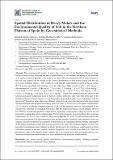Por favor, use este identificador para citar o enlazar a este item:
http://hdl.handle.net/10261/152361COMPARTIR / EXPORTAR:
 SHARE SHARE
 CORE
BASE CORE
BASE
|
|
| Visualizar otros formatos: MARC | Dublin Core | RDF | ORE | MODS | METS | DIDL | DATACITE | |

| Título: | Spatial Distribution of Heavy Metals and the Environmental Quality of Soil in the Northern Plateau of Spain by Geostatistical Methods |
Autor: | Santos-Francés, Fernando; Martínez-Graña, Antonio Miguel; Ávila-Zarza, Carmelo; García Sánchez, Antonio CSIC; Alonso Rojo, Pilar | Palabras clave: | Soil Heavy metals Spatial distribution Environmental quality Kriging Principal component analysis Northern Plateau of Spain |
Fecha de publicación: | 2017 | Editor: | Multidisciplinary Digital Publishing Institute | Citación: | International Journal of Environmental Research and Public Health 14(6): 568 (2017) | Resumen: | The environmental quality of soil in the central part of the Northern Plateau of Spain has been analyzed by studying the heavy metal content of 166 samples belonging to the horizons A, B and C of 89 soil profiles. The analysis to assess the environmental risk of heavy metals in the soil was carried out by means of the spatial distribution of nine heavy metals and the use of several pollution indices. The results showed that the concentration values of heavy metals (x ± S) in the superficial soil horizons were the following: With a total of 6.71 ± 3.51 mg kg −1, the contents of Cd is 0.08 ± 0.06 mg kg−1, Co is 6.49 ± 3.21 mg kg−1, Cu is 17.19 ± 10.69 mg kg−1, Cr is 18.68 ± 12.28 mg kg−1, Hg is 0.083 ± 0.063 mg kg−1, Ni is 12.05 ± 6.76 mg kg−1, Pb is 14.10 ± 11.32 mg kg−1 and Zn is 35.31 ± 14.63 mg kg−1. These nine metals exceed the values of the natural geological background level of Tertiary period sediments and rocks that form part of the Northern Plateau in Spain. Nemerow and Potential Ecological Risk indices were calculated, with the “improved” Nemerow index allowing pollution within the soil superficial horizons to be determined. The data obtained indicated that the majority of the soil (54.61%) showed low to moderate contamination, 22.31% showed moderate contamination and 21.54% of the samples were not contaminated. If we consider the Potential of Ecological Risk Index (RI), the largest percentage of soil samples showed low (70.79%) to moderate (25.38%) ecological risk of potential contamination, where the rest of the soil presented a considerable risk of contamination. The nine trace elements were divided into three principal components: PC1 (Cu, Cr, Ni, Co and Zn), PC2 (As and Hg) and PC3 (Cd). All metals accumulated in the soil came from parent rock, agricultural practices and the run-off of residual waters towards rivers and streams caused by industrial development and an increase in population density. Finally, cartography of the spatial distribution of the heavy metal contents in the soil of the Northern Plateau of Spain was generated using Kriging interpolation methods. Furthermore, the total heavy metal contents in three soil orders present in the area, namely Entisols, Inceptisols, and Alfisols, were analyzed. Other soil parameters, such as the organic matter content, pH, clay content and cation exchange capacity, was measured to determine their influence on and correlation with the heavy metal contents. | Descripción: | 20 páginas, 6 figuras y 9 tablas | Versión del editor: | http://dx.doi.org/10.3390/ijerph14060568 | URI: | http://hdl.handle.net/10261/152361 | DOI: | 10.3390/ijerph14060568 | E-ISSN: | 1660-4601 |
| Aparece en las colecciones: | (IRNASA) Artículos |
Ficheros en este ítem:
| Fichero | Descripción | Tamaño | Formato | |
|---|---|---|---|---|
| Spatial Distribution of Heavy Metals and the Environmental Quality of Soil in the Northern Plateau of Spain by Geostatistical Methods.pdf | Artículo principal | 12,33 MB | Adobe PDF |  Visualizar/Abrir |
CORE Recommender
PubMed Central
Citations
10
checked on 24-abr-2024
SCOPUSTM
Citations
84
checked on 19-abr-2024
WEB OF SCIENCETM
Citations
62
checked on 23-feb-2024
Page view(s)
378
checked on 23-abr-2024
Download(s)
261
checked on 23-abr-2024

